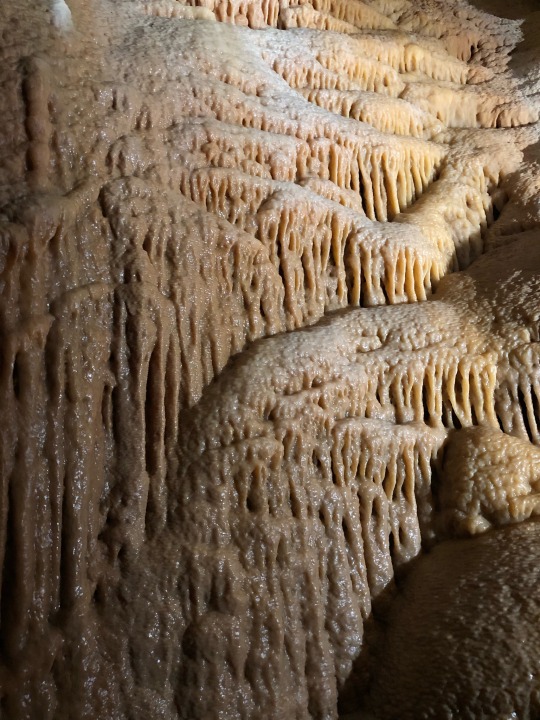#jenolan caves
Explore tagged Tumblr posts
Text
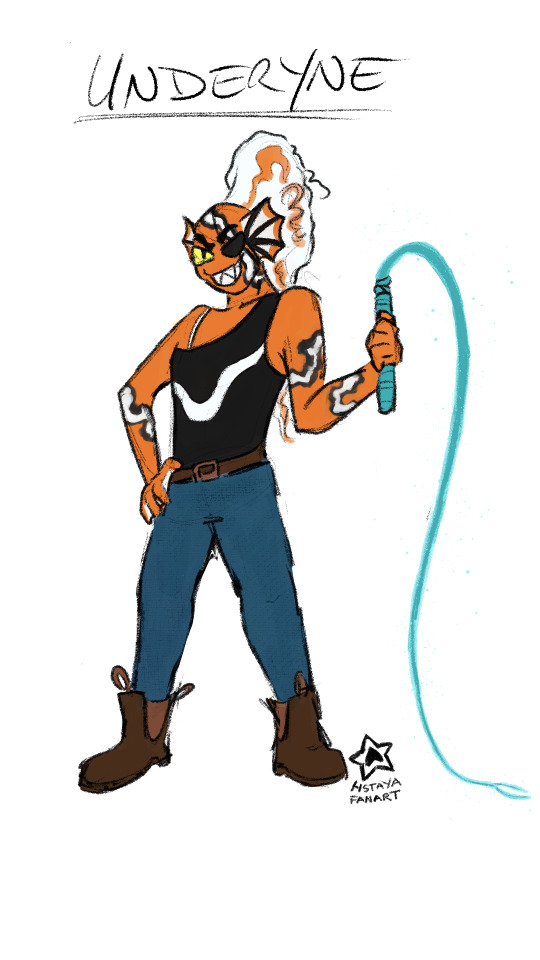
Anyway, so here's my hilarious ongoing joke AU called Down Under, starting with clownfish Undyne haha
I was writing my 'Blue makes a truce between the gang and the Stars' fic and I needed a positive AU. I was looking for something a little less commonly used, and I was like, oh, is there an Aussie themed Undertale AU? And as far as I can find, the answer is no?
EDIT: Actually, turns out there is! Eschatale has some sick-ass designs!
I don't know a lot else about it yet, just that Waterfall would be based on the Great Barrier Reef (complete with anemones that only Undyne is immune to?), Hotland would be the outback, and maybe I'd change Snowdin into bushland? A bit like how Underswap has Sunnedout. The Ruins might be the Jenolan caves or Lightning Ridge or something. Not sure about New Home yet.
Also, maybe frilled-neck lizard or goanna Alphys. Haven't decided on that one yet.
Alphys is done!
Meet the world of Down Under - a very serious Australian Undertale AU!
56 notes
·
View notes
Note

Jenolan Caves, NSW, Australia
18 notes
·
View notes
Text
the oldest known cave system is like ~340 million years old (the Jenolan Caves in Australia). gotta be older caves than that. somebody should take some ground penetrating radar to the pilbara craton and poke around.
7 notes
·
View notes
Text
Kangaroos at last! (Week 6)
With the summer semester over by the start of February, it was time to get serious with the beginning of Term 1. But first, O-Week! O-Week stands for Orientation Week and is the week prior to the start of classes where, everyday, there is a never-ending community of booths all around campus. Each booth is there for a society, club, or organization ranging from Rubik’s Cube club to Surfing society! I was personally excited by the Social Volleyball club, Soccer club, as well as some wilderness and rock climbing ones. After scanning countless QR codes and meeting tons of students who were eager to sell their clubs, it was time to try an Australian sausage sizzle! Imagine a hotdog, but replace the curated, curved bun with a piece of bread. Quite literally, the sausage sizzle is a sausage on a square piece of white bread. Beyond being confused, I was simply a little disappointed. Maybe hotdogs are better left in buns freshly toasted off an American grill…

My roommates and I wanted to capitalize on the extra week of no classes, so a last-minute road trip was in order. In just two days, we rented a car and planned a trip all around Southeast New South Wales, just south of Sydney. Before we knew it, Lauren, Charlotte, Shaunak, Evan, Anthony, and I set off towards the Jenolan Caves just a 3.5hr drive away. Full of wallabies hopping around on beautiful trails around the conservation reserve, the little Jenolan town more than exceeded our expectations. Not to mention the incredible caves! Stalagmites, stalactites, crystals, and a perfectly clear river were just a few of the attractions we witnessed on our guided tour.
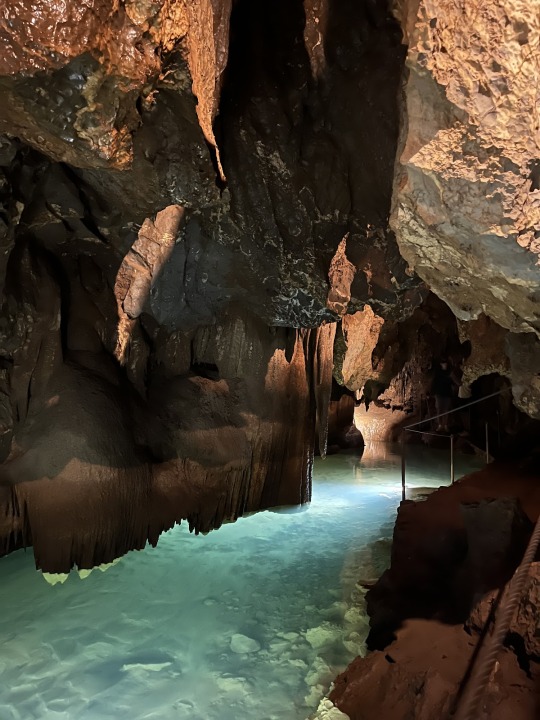
From there, we made our way towards Narooma, a small coastal town with an incredible beach and coastal view. On the way there we passed through a small national park, and I laid eyes on my first wild kangaroos! As soon as I saw one, I saw dozens. Some were single, some in pairs or small groups, but all blended in well with the surrounding trees. It was hard to contain my excitement in the car, but soon enough we would get up close and my excitement could infect my surroundings. While standing at the Narooma coast, we were pleasantly surprised to see seals sunbathing on rocks and even dolphins surfing the waves! As someone whose happiness levels directly correlate to the number of wild animals I’ve recently seen, I was beaming.
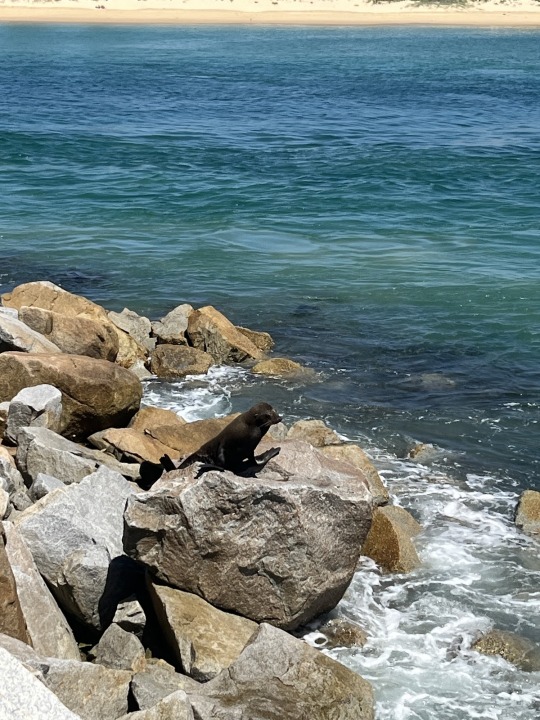
I haven’t even mentioned the infinite number of cows, sheep, goats, horses, and chickens we laid eyes on during the drive. I was honestly astonished at how similar rural Australia is to the rural areas of midwestern states. Just add some more hills and ocean beaches to Wisconsin, and before you know it you’ll feel like you’re in Australia. After Narooma, we drove to Jervis Bay where we watched the sunset and the next morning went to Cave Beach through Booderee National Park. There, we were greeted by two dozen kangaroos at the entrance to the beach.
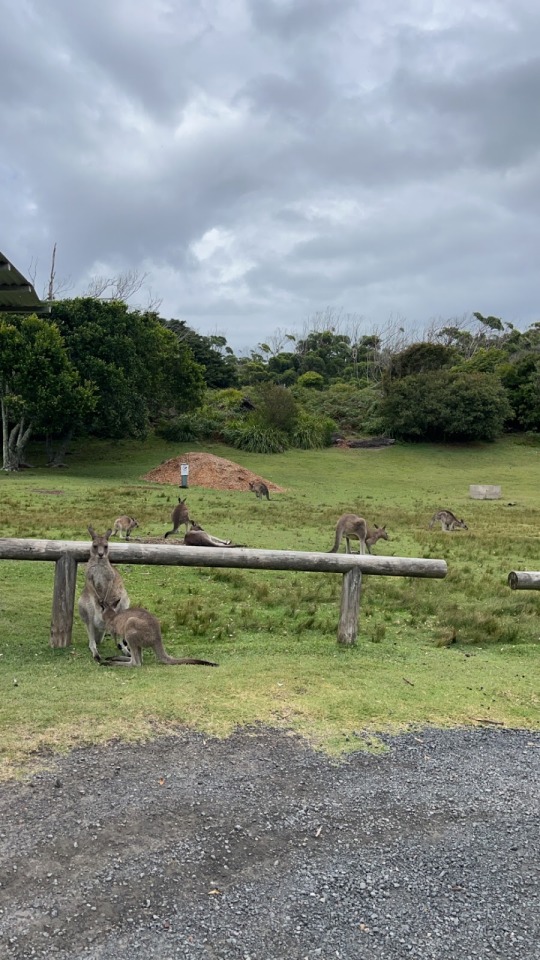
We had only spent 3 days outside the city and all of a sudden, kangaroos were commonplace. The trip ended with a drive through Kangaroo Valley to Fitzroy falls where we did a quick hike before heading towards Kiama, another coastal town not far from Sydney.

Famous for Kiama’s Blowhole, a rock formation which shoots big ocean waves into the sky, Kiama was a cute town with nice shops and restaurants.

Just like that, we were back in Coogee and I was back to soaking up the beauty right outside my own front door.
David Bayer
Biomedical Engineering
University of New South Wales in Sydney, Australia
3 notes
·
View notes
Text
Australian science-adjacent people really like using microwaves incorrectly..
I once watched a Jenolan Caves tour guide blow up the crotchety old office microwave with a metal lined food packet immediately after talking about how different metals and minerals react to electricity. There was a lot of panicked yelling when the pretty blue lights began lol.
openin’ the door to the microwave one second early because you don’t need all the hootin’ and hollerin’
72K notes
·
View notes
Text
Experience the Best Blue Mountains Day Tours
Embark on an unforgettable journey through the Blue Mountains Day Tours with our guide to the best day tours, promising unparalleled experiences in one of Australia’s most iconic natural landscapes.
Introduction to the Blue Mountains
Just a short drive from Sydney, the Blue Mountains beckon with their majestic vistas, ancient rock formations, and lush valleys. Discover the perfect blend of adventure, natural beauty, and cultural heritage on these top-rated day tours.
1. Echo Point and the Three Sisters
Start your exploration at Echo Point in Katoomba, home to the legendary Three Sisters rock formation. According to Aboriginal legend, these three towering rocks represent three sisters turned to stone. Enjoy panoramic views of the Jamison Valley and take a stroll along scenic walking trails that offer glimpses of the region’s breathtaking landscapes.
2. Scenic World Adventure
No visit to the Blue Mountains is complete without experiencing Scenic World in Katoomba. Ride the world’s steepest railway, the Scenic Railway, plunging into the heart of the Jamison Valley rainforest. Alternatively, soar above the treetops on the Scenic Skyway, a glass-floored cable car offering unparalleled views of Katoomba Falls, the Three Sisters, and the lush canopy below.
3. Jenolan Caves Discovery
Explore the wonders of the Jenolan Caves, a labyrinth of ancient limestone formations located within the Blue Mountains. Join a guided tour of the Lucas Cave, renowned for its Cathedral Chamber and impressive limestone formations. Discover the underground rivers and marvel at the natural beauty preserved within this UNESCO World Heritage site.
4. Blue Mountains Botanic Garden
Relax and unwind at the Blue Mountains Botanic Garden on Mount Tomah, a haven for plant enthusiasts and nature lovers alike. Wander through themed gardens like the Gondwana Walk, showcasing ancient plant species, or admire the towering conifers in the Conifer Collection. Take in panoramic views of the mountains while exploring this serene botanical oasis.
5. Outdoor Adventures
Bushwalking and Hiking
The Blue Mountains day tours offer a myriad of bushwalking and hiking trails suitable for all levels of fitness. From leisurely strolls through tranquil rainforests to challenging hikes with sweeping valley views, there’s a trail for every adventurer. Don’t miss the iconic Grand Canyon Walk or the rugged National Pass for a true Blue Mountains experience.
Abseiling and Rock Climbing
For adrenaline junkies, the Blue Mountains day tours provide ample opportunities for abseiling and rock climbing amidst stunning natural backdrops. Whether you’re a beginner or a seasoned climber, guided tours and courses are available to ensure a safe and exhilarating experience.
Mountain Biking
Explore the rugged terrain of the Blue Mountains on two wheels with thrilling mountain biking adventures. Ride through forested trails, tackle challenging descents, and soak in the scenic beauty of this UNESCO-listed wilderness.
6. Cultural Insights and Historical Sites
Aboriginal Heritage
Learn about the rich Aboriginal culture and heritage of the Blue Mountains through guided tours that highlight ancient rock art, sacred sites, and Dreamtime stories. Gain a deeper appreciation for the spiritual significance of this land to the local indigenous communities.
Historic Villages
Discover quaint villages like Leura and Blackheath, each offering its own unique charm and history. Explore boutique shops, art galleries, and local cafes nestled amidst stunning mountain scenery.
Planning Your Blue Mountains Day Tours
Tips for a Memorable Visit
Plan Ahead: Research attractions and create an itinerary that suits your interests and timeline.
Pack Essentials: Wear comfortable clothing and footwear suitable for outdoor activities. Don’t forget sunscreen, a hat, and plenty of water.
Respect Nature: Follow designated trails, respect wildlife habitats, and leave no trace of your visit to help preserve the natural beauty of the Blue Mountains.
Conclusion
Embark on a journey of discovery and adventure with the best Blue Mountains day tours. Whether you’re seeking thrilling outdoor activities, cultural insights, or serene natural beauty, the Blue Mountains offer an unforgettable escape into Australia’s wilderness.
0 notes
Text
Exploring the Best Camper Trailer Destinations in NSW
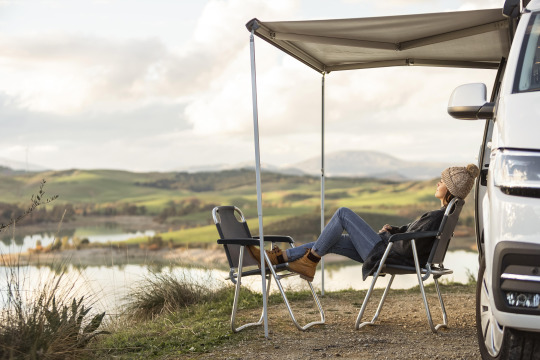
New South Wales (NSW), Australia, offers a myriad of stunning landscapes and diverse environments perfect for camper trailer enthusiasts. From lush coastal regions to rugged inland terrain, NSW has something to satisfy every adventurer's thirst for exploration. Here’s a guide to some of the best camper trailer destinations in NSW that promise unforgettable experiences.
Royal National Park
Located just south of Sydney, Royal National Park is a haven for nature lovers. It's one of the world's oldest national parks and offers a blend of coastal and bushland scenery. Campgrounds such as Bonnie Vale provide facilities for camper trailers and easy access to hiking trails, pristine beaches, and the picturesque Wattamolla Beach. Don’t miss the Figure Eight Pools, a natural wonder worth the hike.
Kosciuszko National Park
Home to Australia’s highest peak, Mount Kosciuszko, this national park is perfect for those looking to combine their camping trip with some serious hiking. The park's campgrounds, like Thredbo Diggings, are equipped to handle camper trailers and offer stunning alpine views. In winter, it transforms into a snowy wonderland ideal for skiing and snowboarding.
Blue Mountains National Park
The Blue Mountains, known for their dramatic cliffs, eucalyptus forests, and cascading waterfalls, are a must-visit. Sites like the Euroka Campground in Glenbrook provide excellent amenities for camper trailers. Explore iconic landmarks such as the Three Sisters, Wentworth Falls, and the Jenolan Caves. The region also offers various walking trails, catering to all levels of hiking enthusiasts.
Myall Lakes National Park
For those who love water activities, Myall Lakes National Park is the perfect destination. The park features one of the largest lake systems on the NSW coast, ideal for kayaking, boating, and fishing. Campgrounds like Mungo Brush offer waterfront sites, allowing easy access to the serene lakes and lush rainforests.
Byron Bay
Byron Bay is renowned for its laid-back vibe, beautiful beaches, and vibrant arts scene. Belongil Fields and First Sun Holiday Park are popular choices for camper trailer sites. Enjoy the local markets, surf the famous waves, or simply relax on the beach. The Cape Byron Lighthouse offers breathtaking views and is a great spot for whale watching during migration seasons.
Barrington Tops National Park
This World Heritage-listed area boasts ancient rainforests and subalpine woodlands. Campgrounds like Gloucester River offer basic facilities but immerse you in the park’s natural beauty. Barrington Tops is ideal for hiking, with trails leading to stunning lookouts and cascading waterfalls. It's also a fantastic spot for birdwatching and spotting wildlife.
South Coast – Jervis Bay
Jervis Bay is famous for its white sand beaches and crystal-clear waters. The region’s campgrounds, such as the ones in Booderee National Park, cater to camper trailers and provide a gateway to beautiful beaches like Hyams Beach. Snorkeling, diving, and dolphin watching are popular activities here, making it a great destination for families.
Mungo National Park
Step back in time with a visit to Mungo National Park, part of the Willandra Lakes Region World Heritage Area. The Walls of China, with their striking sand formations, are a highlight. Campgrounds like Main Camp offer basic amenities for camper trailers. This park is rich in Aboriginal history and offers guided tours to learn about its cultural significance.
Tips for Camper Trailer Travel in NSW
Plan Ahead: Some campgrounds require bookings in advance, especially during peak seasons.
Check Accessibility: Ensure your camper trailer can access the chosen site, as some roads might be challenging.
Pack Accordingly: NSW’s climate can vary greatly, so bring appropriate clothing and gear.
Respect Nature: Follow the “Leave No Trace” principles to preserve the natural beauty of these destinations.
1 note
·
View note
Text
0 notes
Text
Blue Mountains Day Tour
Introduction:- Experience the majestic beauty of the Blue Mountains on a day tour with PJ Tours. Our expert local guides will take you to top attractions like the Three Sisters rock formation, Scenic World rides, and Echo Point lookouts. See stunning valley views, waterfalls, forests, and more as you travel in luxury coaches. With personalized attention, relaxing walks, and gourmet lunches, PJ Tours shares the highlights of the Blue Mountains while ensuring a revitalizing escape from Sydney. For the ultimate Blue Mountains day tour showcasing breathtaking scenery and local secrets, choose the trusted experts at PJ Tours.

PJ Blue Mountains Supreme (Private)
Blue Mountains Highlights Day Tour from Sydney
Complimentary pick-up from your Sydney hotel or home
Visit Featherdale Wildlife Park to see Australian animals
Get up close with kangaroos and wallabies
Explore charming Leura Village
Marvel at Echo Point's Three Sisters rock formation
Hear Aboriginal stories behind the Three Sisters
360 degree views on the Scenic Skyway
Descend into Jamison Valley on the Scenic Cableway
Walk through ancient rainforest on the Scenic Walkway
Ride the world's steepest railway - Scenic Railway
Enjoy peaceful Megalong Valley's views and serenity
Return to Sydney by relaxed river cruise
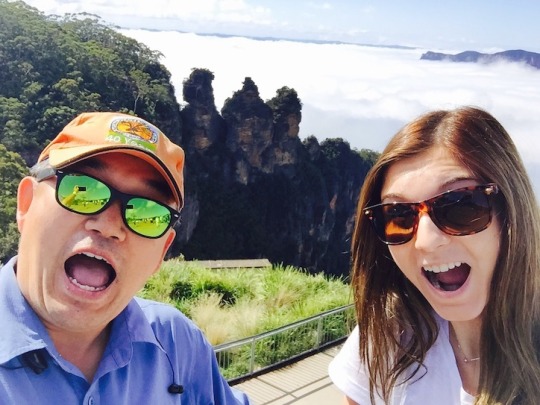
PJ Blue Mountains PRIVATE TRANSFER ONLY
Blue Mountains Highlights Small Group Day Tour
Complimentary pick-up from your Sydney hotel
Explore charming Leura Village
Marvel at Three Sisters rock formation at Echo Point
Hear Aboriginal legends behind the Three Sisters
360 degree views on the Scenic Skyway
Descend into Jamison Valley on Scenic Cableway
Walk through ancient rainforest on Scenic Walkway
Ride the world's steepest railway - Scenic Railway
Enjoy peaceful Megalong Valley's views
Return to your Sydney hotel
Experience the top sights of the Blue Mountains on this personalized small group tour.
PJ Blue Mt. & Jenolan Caves
Ultimate Blue Mountains Highlights Day Tour from Sydney
Pickup from your Sydney CBD hotel
Walk the boardwalk through rainforest at Scenic World
Ride the Scenic Skyway for valley views
Descend into the valley on the Scenic Cableway
Walk the ancient rainforest on the Scenic Walkway
Ride the world's steepest railway - Scenic Railway
Marvel at the Sound of Silence lookout
See the Grand Arch at Jenolan Caves
Take a guided tour of Imperial, Chifley or Lucas Cave
Photograph the beautiful Blue Lake
Spot wallabies in peaceful bushland
Return to your Sydney CBD hotel
Experience the top Blue Mountains attractions on this complete 1-day tour from Sydney.
PJ Port Stephens Supreme with Quad Bike (Private)
Schedule:- Port Stephens Day Tour Itinerary from Sydney
7:00-7:30am - Pickup from Sydney CBD hotel
8:45am - Stop at service station (30 mins)
10:45am - Arrive at Williamtown for quad biking (1 hr)
12:30pm - Free time in Nelson Bay for fish market and lunch (own cost)
1:30pm - Dolphin cruise in Nelson Bay
OR
12:30pm - Sand dune and sandboarding tour in Anna Bay
1:45pm - Free time in Nelson Bay for fish market and lunch (own cost)
3:15pm - Depart for Murrays Brewery
3:30pm - Stop at Murrays Brewery for tasting
4:00pm - Return to Sydney
5:15pm - Stop at service station (15 mins)
7:00-7:30 pm - Arrive back at Sydney CBD hotel
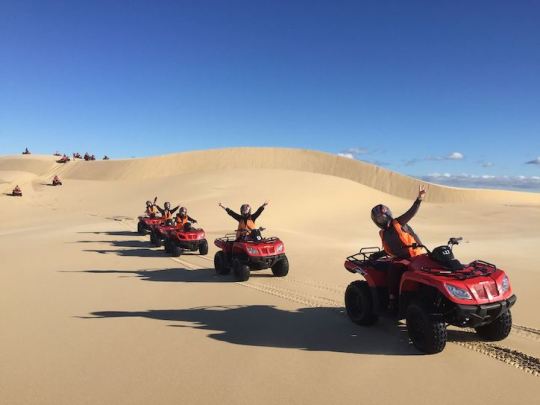
Inclusions & Exclusions
One-hour Quad Bike adventure
National park levy
Sandboarding at Anna Bay & Stockton Beach or Dolphin Cruise
Visit to Murray's Brewery & Port Stephens Winery
Friendly and knowledgeable expert guides
Comfortable transportation in air-conditioned modern buses
1 note
·
View note
Text
Geheimtipps: Sehenswürdigkeiten in Sydney und New South Wales
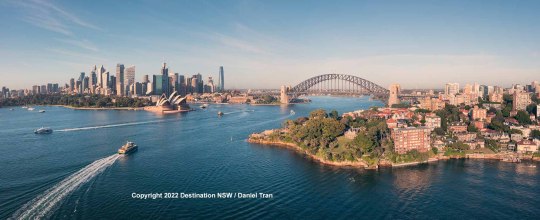
Sharlene Lowe ist Flugbegleiterin bei der internationalen Airline Emirates. Sie verrät uns als Einheimische Geheimtipps für Sehenswürdigkeiten in Sydney und New South Wales.
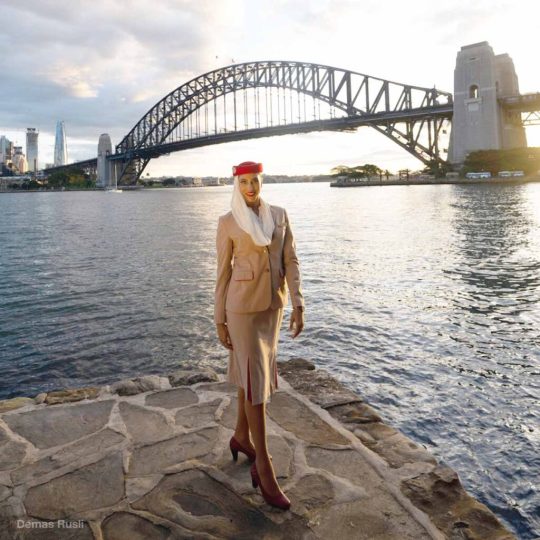
Sharlene Lowe ist Flugbegleiterin bei Emirates und verrät ihre persönlichen Empfehlungen für Sehenswürdigkeiten in Sydney und New South Wales in ihrem Heimatland Australien. / Foto: Emirates
Hier ist ihre Liste
- Jenolan Caves in den Blue Mountains (https://www.jenolancaves.org.au/) : Die Jenolan Caves sind ein beeindruckendes Kalksteinhöhlensystem mit atemberaubenden Formationen, unterirdischen Flüssen und geführten Touren, die für Besucher ein einzigartiges und magisches Erlebnis darstellen. Sie gehören zu den ältesten Höhlen der Welt und sind für ihre uralte geologische Bedeutung bekannt. Noch heute gibt es dort Kunstwerke zu sehen, die von den Aborigines, die hier vor Zehntausenden von Jahren lebten, an die Wände gemalt wurden. - Wollomombi Falls (https://www.nationalparks.nsw.gov.au/things-to-do/picnic-areas/wollomombi-falls-picnic-area): Einer der höchsten Wasserfälle Australiens ist mit einer Fallhöhe von 230 Metern ein weiteres faszinierendes Naturwunder, das im oberen Teil des Oxley Wild Rivers National Park liegt. Zu den Wasserfällen führt der Wollomombi-Wanderweg, der exotische Vögel und andere Wildtiere beheimatet - ein idealer Ort für Naturliebhaber. - Warrumbungle National Park (https://www.nationalparks.nsw.gov.au/visit-a-park/parks/warrumbungle-national-park): Dieser Park ist mit seinen beeindruckenden Felsformationen und dem ausgewiesenen Dark Sky Park ein Paradies für Sternengucker. Da es hier keine Lichtverschmutzung gibt, ist der Nachthimmel besonders lebendig und bietet fantastische Möglichkeiten für Buschwanderungen und Sternenbeobachtungen. - Bellingen (https://www.visitnsw.com/destinations/north-coast/coffs-harbour-area/bellingen): Auf halbem Weg zwischen Sydney und Brisbane liegt diese unkonventionelle Stadt zwischen den Bergen und dem Meer. Hier herrscht eine künstlerische und entspannte Atmosphäre. Auf dem wöchentlichen Bellingen Farmers Market werden regionale Spezialitäten und Produkte direkt vom Bauernhof angeboten. - Sydney Harbour Bridge Pylon Museum: Hier lässt sich die reiche Geschichte eines der wichtigsten Wahrzeichen der Stadt in einem Virtual-Reality-Erlebnis entdecken. Nach dem Aufstieg von 200 Stufen zum Pylon Lookout erwartet Besucher ein malerischer Blick auf die lebhafte Stadt Sydney. Von dort aus reicht der Blick auch bis zur Sydney Harbour Bridge und zum üppigen botanischen Garten. - Bronte (https://pylonlookout.com.au/): Ein weiterer einzigartiger Ort ist Bronte - ein Juwel am Strand mit herrlichen Meeresschwimmbecken, grünen Parks, die sich perfekt für Picknicks am Meer eignen, und kristallklarem Wasser, das zum Schnorcheln und Tauchen einlädt. Auf der südlichen Landzunge finden sich die Bronte Baths, ein historisches Schwimmbad im Meer aus dem Jahr 1887, sowie der Bogey Hole Rock Pool. - Manly Wormhole (http://www.queenscliff.com.au/): Das Manly Wormhole ist eines der historischen Geheimnisse Sydneys, von dem aus Reisende einen malerischen Blick auf den Freshwater Beach und auf den Ozean genießen, besonders bei Sonnenuntergang. Ganz in der Nähe des Strandes kann im Restaurant Pilu at Freshwater gespeist werden. Das Lokal serviert italienische Küche und ist von Jasmin-Gärten umgeben. Ein idealer Ort für ein Abendessen, bei dem Reisende die Landschaft in ihrer vollen Pracht genießen können. - Paddington Reservoir Gardens (https://www.cityofsydney.nsw.gov.au/parks/paddington-reservoir-gardens): Wie wäre es mit einem Spaziergang durch die makellosen Paddington Reservoir Gardens? Auf dem Dach befinden sich ein wunderschöner Garten und spannende Graffiti-Kunst. Die Gärten sind auch der perfekte Ort, um den Sonnenuntergang zu beobachten und zu sehen, wie die Beleuchtung die Gärten optisch verwandelt. Titelfoto / Rechts die Harbour Bridge, links die Oper / Copyright 2022 Destination NSW / Daniel Tran
Auch interessant:
Read the full article
0 notes
Text
The Blue Lake at the entrance to Jenolan Caves, Blue Mountains, Australia
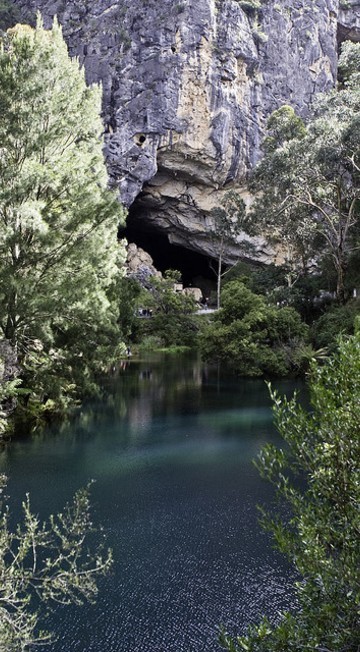
0 notes
Text
Underground pools of Jenolan Caves, New South Wales, Australia
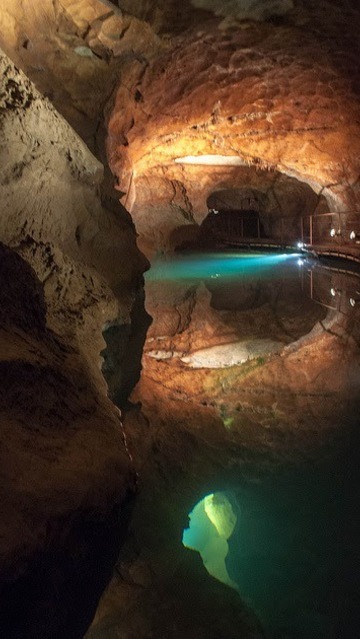
0 notes
Link
Fun Things to Do in Jenolan Caves | Travel Guide (2023) | Best Places to Visit
0 notes
Note
Hi! question I will be traveling to Sydney soon(this Sunday lmao I’ll be there for a week) do you have any recommendations? Tips? Good food ☺️?? Places to be weary of 👀🕵🏻♀️
Thank you in advanced i really appreciate any help ♥️
I have the the blue mountains in my list suggested by @DisillusionedMonster ✨
It depends on what you're interested in doing! We've been having a lot of train disruptions, you can keep track of them if you're using the train systems with the free train app (tripview).
I'd highly recommend going to Jenolan Caves and/or Wombeyan Caves, the caves are great and there are some short and easy walking tracks around them.
I'd also highly recommend doing some bush walks/nature walks, you can find some of the popular ones here (I've done Bradleys Head to Chowder Bay, America Bay, Henry Head, Lane Cove - I think Lane Cove is my favourite).
I'm not sure what to recommend in terms of food - avoid the tourist areas like Circular Quay and Darling Harbour? We have a lot of farmers markets and things if you're looking for fresh produce (here), a lot of great Asian food (according to my Dutch friend - you'll be able to look the best places up near where you're staying), or some cool vegan places (like Bad Hombres, which is really great all-vegan Mexican food ((South Western Sydney has a lot of great food too, e.g. Malaysian, Korean, Indian, Tongan - pretty much everything)).
I hope you enjoy your trip here!
#I only just saw this sorry!!#i'd avoid bondi tbh - giant tourist trap + there are plenty of other fine beaches#anon
1 note
·
View note
Text
New South Wales
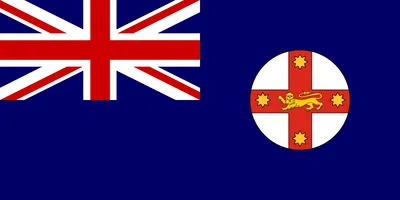
New South Wales is the oldest and most populous state in Australia, located in the southeastern part of the country. It covers an area of more than 800,000 square kilometers and is home to over 8 million people. The capital city is Sydney, which is also the largest city in the state and the most populous city in Australia. New South Wales is a beautiful and captivating state with a rich cultural heritage, diverse ecosystems, and a booming economy. The state has a fascinating history that dates back to the arrival of British settlers in 1788. It was named 'New South Wales' by Captain James Cook who was inspired by the similarity between the coastline of the state and that of Wales in the United Kingdom. Throughout the years, New South Wales has gone through numerous transformations and has emerged as a powerful force in the region. Geologically, New South Wales is located on the Australian Plate and consists mostly of sedimentary rocks. The state is divided into four main regions, namely the eastern highlands, the central west, the Murray-Darling Basin, and the coastal plains. It is also home to a number of stunning natural landmarks such as the Blue Mountains, the Jenolan Caves, and the Snowy Mountains. With a population of over 8 million people, New South Wales is a diverse state with a rich multicultural heritage. The state is home to numerous ethnic groups, and the most common languages spoken are English, Mandarin, Arabic, Cantonese, and Vietnamese. Christianity is the dominant religion in the state, followed by Buddhism, Islam, and Hinduism. The state's economy is diverse, with services, manufacturing, and agriculture being the main sectors. It is a major contributor to the national economy, generating a gross state product of over $500 billion. Sydney is the country's financial and economic capital, with a thriving business community and a bustling retail sector. There is a lot to discover and explore in New South Wales, from its vibrant cities to its untouched wilderness areas. Visitors to the state can enjoy a variety of activities, such as bushwalking, surfing, skiing, and winery tours. The state has some of the country's most beautiful cities, including Sydney, Newcastle, and Wollongong. New South Wales is a state like no other, with a unique blend of history, culture, and natural beauty. Whether you're a visitor or a resident, there's always something new and exciting to discover in this incredible part of Australia.
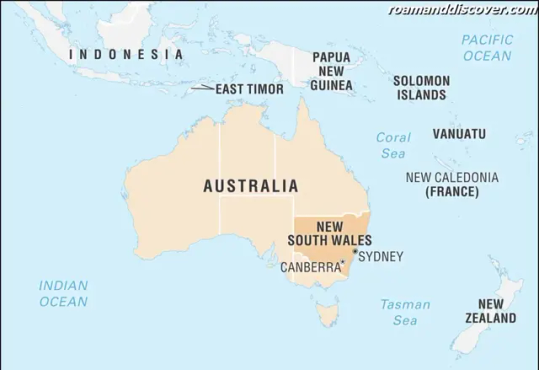
Etymology
New South Wales, one of the six Australian states, is situated on the country's south-east coast, bordered by Queensland to the north, South Australia to the west, and Victoria to the south. The state's name, New South Wales, reflects its connection to the United Kingdom. Captain James Cook, who mapped out Australia's east coast in 1770 during the first of his three voyages of discovery, named the territory 'New South Wales' after the Welsh principality at the time. The name also honored King George III of England, who was from the House of Hanover's German royal family. After the British Crown claimed the land in 1788 and established a penal colony on the land, New South Wales became an official British colony. The state has a history of being a place where convicts were brought, and many of Australia's most notorious criminals were incarcerated there. The name declared by the Government of New South Wales is efficient in giving an image of the state's primary place, and it stands out among the relatively imaginative names for the Australian states. The land territory of New South Wales was initially marked by a further term, "South Wales," which represents the state's rough similarity to the South Wales district of the Kingdom of England, which combines coal mining and an offshore coast. Another goal in connecting the name to Wales was to capitalize on the cultural image given off by Wales with its black coal and green valleys, a picture readily linked with the British Isles' western regions. Captain Cook was under the belief that this new land had equivalent traits. The lands were alike in that they possessed mines and clear coastlines. The 'new' was added because the state was fresh to European explorers. Today, New South Wales is the country's most populous state, and it remains a popular tourist destination for both locals and international visitors alike. Its capital city, Sydney, is one of the most famous cities in the world, globally recognized for its iconic landmarks such as the Sydney Opera House and Harbour Bridge. The origin story of New South Wales' name represents the state's rich history and the continuous influence that the United Kingdom has on its culture and identity.
History
The history of New South Wales began with the arrival of the British in 1788 when Captain Arthur Phillip led the First Fleet to Australia. Convicts were sent to the colony as punishment for their crimes, and the settlement quickly grew in size. In 1810, Lachlan Macquarie became the governor of the colony and initiated significant reforms, including the construction of public buildings and infrastructure. In the mid-19th century, New South Wales experienced a gold rush that led to a population boom. The discovery of gold in places like Bathurst and the city of Orange led to the rapid development of mining towns and cities, increasing the state's wealth. Throughout the 20th century, New South Wales faced numerous challenges, including two world wars and the Great Depression. The state played a crucial role in the allied effort during both world wars, with many soldiers, sailors, and airmen coming from New South Wales. The state also experienced significant social and political changes during the 20th century. In the 1960s and 1970s, there was a surge of activism around issues such as women's rights and Aboriginal land rights. The Whitlam Labor government, which came to power in 1972, implemented a range of progressive policies, including free university education and national health insurance. In recent years, New South Wales has experienced rapid population growth and economic development. The state's capital, Sydney, has become a global financial center and a hub of technology and innovation. In 2000, Sydney hosted the Summer Olympics, which provided a massive boost to the state's infrastructure and tourism industries. The state's history is shaped not only by its European colonizers but also by the Indigenous peoples who have lived in the area for thousands of years. The state has a rich Aboriginal heritage, and there are numerous sites across the state that are of cultural and spiritual significance to Aboriginal communities. The New South Wales State Archives and Records Authority is responsible for preserving the state's historical documents and artifacts, including photographs, diaries, and government records. There are also numerous museums and historical sites throughout the state that offer insights into New South Wales' rich cultural heritage. the history of New South Wales is complex and diverse and reflects the many different influences that have shaped the state over the years.
Geology
New South Wales is a state in southeastern Australia that boasts diverse and breathtaking landscapes. The state has a rich geological history, with geological formations that date back millions of years. Most of New South Wales is made up of the Australian Shield, which is a large section of the continent's basement rock that was formed over 2.5 billion years ago. The Shield is largely composed of granite and gneiss, and it extends across the eastern part of the state. The eastern coast of New South Wales is characterized by the Great Dividing Range, which is a series of mountain ranges that extend for over 3,500 kilometers. The range is made up of sedimentary and metamorphic rocks, including sandstone, shale, and limestone. One of the most distinctive geological features of New South Wales is the Sydney Basin, which is a large sedimentary basin that contains the city of Sydney. The basin was formed over 250 million years ago and contains rocks that range in age from around 300 million to 180 million years old. The basin is also home to coal deposits that have been mined for over 200 years. In addition to the Sydney Basin, there are several other sedimentary basins in New South Wales, including the Gunnedah Basin, the Murray Basin, and the Clarence-Moreton Basin. These basins contain a wide variety of sedimentary rocks, including sandstone, shale, and coal. New South Wales is also home to several volcanic rocks, including basalt and rhyolite. The state has a number of extinct volcanoes and volcanic plugs, such as Mount Kaputar and the Warrumbungles. These volcanic features offer some of the most stunning landscapes in the state. The state's mineral resources include coal, gold, copper, silver, lead, and zinc. The mining industry is an important part of the state's economy and has played a significant role in its history. - Coal - the state is the largest producer of coal in Australia, with most of it coming from the Hunter Valley and Illawarra regions - Gold - is mined in several regions of the state, including the Central West and the New England regions - Copper - is mined in the Cobar region, which is also a significant producer of silver and lead New South Wales's geological features have played a significant role in shaping the state's history and economy. The diverse landscapes and mineral resources continue to provide opportunities for tourism and development.
Geography
New South Wales is the most populous state in Australia and is located in the southeastern region of the country. It has a diverse geography that ranges from stunning coastlines to rugged mountain ranges, arid deserts, and fertile river valleys. The state encompasses a total area of 800,642 square kilometers and has a total coastline that stretches for over 2000 km. The state's physical geography is divided into four clearly defined regions, namely the eastern highlands, the coastal plain, the western slopes, and the western plains. The eastern highlands consist of the Great Dividing Range, a series of mountain ranges that run parallel to the eastern coast. It is Australia's most extensive mountain range and stretches for over 3,500 kilometers. The coastal plain is a narrow strip of land that runs along the state's eastern coast and encompasses sandy beaches, inlets, and bays. The plain is low-lying and is home to several significant urban centers such as Sydney, Newcastle, and Wollongong. The western slopes of New South Wales comprise the region between the Blue Mountains and the western plains. This region has several well-known wine-growing areas and is home to the farming communities that cultivate wheat, barley, and other crops. The western plains are the state's most arid region and comprise most of the state's interior. The region is characterized by flat plains, rivers, and creeks, and is ideal for grazing cattle and sheep. In terms of human geography, New South Wales is divided into several regions, each with its own unique attributes and characteristics. For instance, the Sydney metropolitan area is the most populous city in the state and is home to over 5 million people. Newcastle, the state's second-largest city, is also a significant industrial center located on the coast. The state's southeastern region is home to the Snowy Mountains, which is a popular recreational destination for ski enthusiasts. The south coast of the state is known for its pristine beaches, while the north coast has an abundance of natural parks and reserves. New South Wales is also home to several national parks, including the Blue Mountains National Park, the Kosciuszko National Park, and the Wollemi National Park. These parks are important wildlife sanctuaries and provide vital habitats for several species of flora and fauna. New South Wales' geography is incredibly diverse and offers several unique experiences to any visitor. Whether you're looking to explore the state's majestic mountain ranges or relax on its stunning beaches, the state's geography has something for everyone.
Ecology
New South Wales is home to a diverse range of ecosystems, including rainforests, woodlands, grasslands, and coastal environments. These ecosystems support a vast array of flora and fauna, many of which are endemic to the region. The state's rainforests are particularly notable, with World Heritage-listed areas such as the Gondwana Rainforests of Australia spanning over 50 national parks and reserves. These ancient ecosystems date back over 100 million years and are home to a vast array of plant and animal species, including the iconic lyrebird and platypus. The woodlands and grasslands of New South Wales are also vital ecosystems, home to a range of iconic species such as kangaroos and koalas. However, many of these ecosystems have been severely impacted by land use changes and climate change, with large areas being cleared for agriculture and urbanization. The state's coastal ecosystems are also under threat, with pollution and erosion impacting the health of marine environments and threatening important fish species. Actions are being taken to protect these ecosystems, including the implementation of marine protected areas and the restoration of shorelines through the planting of native vegetation. The importance of New South Wales' ecosystems cannot be overstated, as they provide vital services such as carbon storage, soil stabilization, and water filtration, in addition to supporting a vast array of biodiversity. The state's natural environments also play a significant role in the tourism industry, attracting millions of visitors each year who come to experience the unique beauty and wildlife of the region. Efforts are currently underway to protect and restore New South Wales' ecosystems, with conservation programs and initiatives aimed at preserving these vital environments for future generations. New South Wales is also home to several important biodiversity hotspots, including the Cumberland Plain, which supports over 300 plant species that are found nowhere else on Earth. The Brigalow Belt South and Nandewar bioregions in the west of the state are also critical biodiversity hotspots, with unique assemblages of plant and animal species. These hotspots are vitally important for conservation efforts, as they contain high levels of endemic species and are under significant threat from habitat loss and fragmentation. Measures are being taken to protect these areas, including the establishment of protected areas and the implementation of habitat restoration programs.
Biodiversity
New South Wales is home to a diverse range of flora and fauna, including many unique and endangered species. The state is blessed with varied landscapes, from the rugged Blue Mountains to the fertile plains of the Riverina, and each region is characterized by different ecosystems. In the east of the state, the Great Dividing Range and its foothills are covered in eucalyptus forests that provide habitat for a variety of marsupials, including kangaroos, wallabies, and possums. The coastal areas are home to sandy beaches, rocky cliffs, and estuaries, which support a rich marine ecosystem with dolphins, seals, and numerous species of fish. The state's western plains are dominated by grasslands and shrublands, which are adapted to the arid climate. Here, red kangaroos, emus, and other desert-adapted animals roam freely. The freshwater wetlands of the Murray-Darling Basin, which stretches across much of southern Australia, provide habitat for many bird species, including waterfowl, cranes, and herons. New South Wales also has a wealth of plant species, with around 13,000 species recorded, representing over 20% of Australia's total flora. The state's vegetation ranges from rainforest and wet sclerophyll forests to grasslands and heathlands. One unique feature of New South Wales' biodiversity is its high number of endemic species, meaning species that occur naturally only in that area. This includes the Wollemi Pine, a prehistoric conifer that was thought to be extinct until it was discovered in the Wollemi National Park in 1994. However, despite its rich biodiversity, New South Wales is facing many threats to its ecosystems. Habitat loss and fragmentation, climate change, and introduced species are some of the major environmental challenges faced by the state. Conservation efforts are underway to protect endangered species and their habitats, but more action will be needed to ensure their continued survival. New South Wales boasts a wide range of unique and diverse flora and fauna. Its varied landscapes and ecosystems provide a home for many species, some of which are found nowhere else in the world. While there are challenges to conserving this biodiversity, it remains an important part of the state's natural heritage that must be protected for future generations.
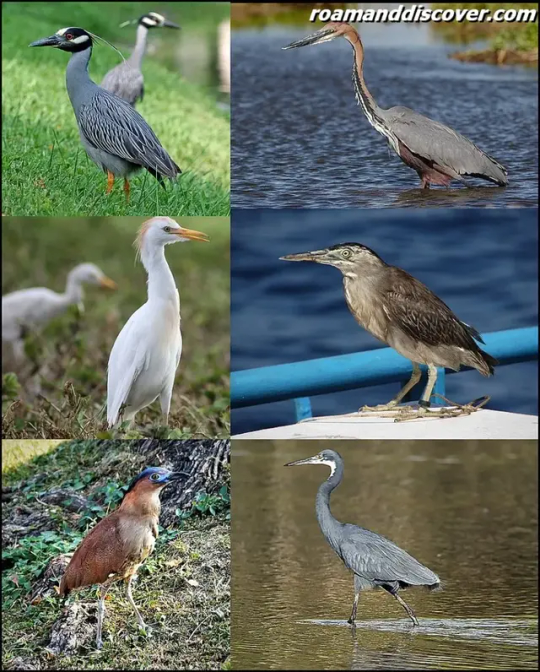
Herons
Climate
Climate plays a significant role in the ecological and geographical landscape of New South Wales. The state experiences varied climatic conditions due to its diverse geography. New South Wales has a temperate climate along the coast, subtropical in the north, and arid in the interior regions. In general, the state experiences warm summers and mild winters. The coastal areas receive rainfall throughout the year, while the interior regions have low precipitation. The mountainous regions in the southeast receive occasional snowfall during the winter season. New South Wales is also susceptible to natural disasters such as floods, bushfires, and droughts. The state faces drought conditions frequently, and the government has implemented various measures to handle these situations effectively. The table below highlights the average temperature and rainfall in some of the major cities of New South Wales: City Summer Average Temperature (°C) Winter Average Temperature (°C) Annual Precipitation (mm) Sydney 26 8 1,213 Newcastle 27 9 1,175 Wollongong 25 7 1,217 Apart from these, New South Wales also experiences a phenomenon called "Southerly Buster," which is a sudden drop in temperature due to a cold front from the south. It brings strong winds, heavy rain, and thunderstorms. However, the state's climate patterns are changing due to global warming, and New South Wales has been experiencing more frequent heatwaves and extreme weather conditions. The state's future climate is expected to become drier and hotter, leading to more devastating bushfires and droughts. New South Wales has various climate-related initiatives focusing on reducing carbon emissions and promoting renewable energy. The government's aim is to create a more sustainable future for its residents while preserving its unique ecology and biodiversity. Read the full article
0 notes
